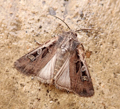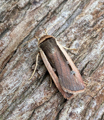2022 Annual Report for: Noctuidae / Noctuinae
For species seen in 2022 that had less than or equal to 100 records, full details are included; for more common species, the earliest, latest and highest count by vice-county are shown. The narrative for each species is taken from the main Hantsmoths website, and it is possible that some information on abundance and occurrence can get out of date, as it is impossible to keep up with all changes; however it should give a good introduction to each species. The tables in each species account summarise the previous status, and that for the current year.
For the maps, all records prior to 2022 are shown by a blue dot (the larger the dot, the more recent), with the current year's records shown in red. As previous records are superimposed on any report for 2022, new sites have greater emphasis (i.e. will show as 'more red').
In the species accounts, an asterisk next to a location indicates a new 10km square record; earliest ever dates are highlighted in orange, and latest ever in red. Initials in the species accounts refer to the recorders listed here. Please get in touch if you identify any omissions or errors, in particular if you have records that have yet to be submitted. Details of how to submit records can be found here.
73.307 [B&F: 2119] Pearly Underwing Peridroma saucia (Hübner, [1808]) - Migrant
Common immigrant from mainland Europe, appearing throughout the British Isles, in some years arriving in sufficient numbers to breed in very small numbers. In Hampshire and on the Isle of Wight a fairly common migrant throughout, most common near the coast. Wingspan 45-56 mm. Thorax with longitudinal crest, often silvery grey. Larva feeds on Dandelion, Dock and Red Clover, causing sufficient damage to be a serious pest in some areas, unable to over-winter in significant numbers.
Records prior to 2022
| Vice County | #Records | #Individuals | First Record | Last Record |
|---|---|---|---|---|
| 10 | 223 | 588 | 1951 | 2021 |
| 11 | 1031 | 1253 | 1949 | 2021 |
| 12 | 102 | 96 | 1951 | 2020 |
2022 records
| Vice County | #Records | #Individuals | Max Quantity |
|---|---|---|---|
| 10 | 30 | 50 | 6 |
| 11 | 67 | 78 | 4 |
| 12 | 5 | 5 | 1 |
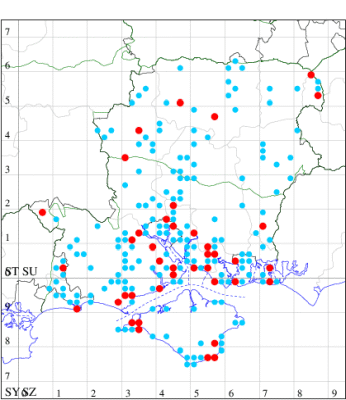
Records by year
Records by week (adult)
Records by week (larval)
Record Summary
VC10: Earliest: Totland, 31 May, 1 (RTer) Latest: Shanklin, 19 Aug, 1 (IOu) Max count: Bonchurch, 07 Sep, 6 (JHa)
VC11: Earliest: Avon Heath Country Park, 16 Aug, 1 (Rbis) Latest: Hayling Island, 07 Dec, 1 (STho) Max count: Fareham, 23 Aug, 4 (KJW)
VC12: Earliest: Anna Valley, Andover, 22 Sep, 1 (TJN) Latest: Farnborough, 22 Sep, 1 (KBW) Max count: Anna Valley, Andover, 22 Sep, 1 (TJN)
73.312 [B&F: 2080] Square-spot Dart Euxoa obelisca ([Denis & Schiffermüller], 1775) - Nb
Nationally scarce (Nb) on sea cliffs and rocky hillsides, along the coasts of southern and western Britain. In Hampshire and on the Isle of Wight probably still frequent on chalk cliffs on the south side of the Isle of Wight, between the Needles and Ventnor. Wingspan 35-40 mm. The most likely confusion species is White-line Dart E. tritici, but in Square-spot Dart the region beyond the postmedian line is almost without markings and nearly always lacks any trace of the wedge-shaped marks which are so often a feature of White-line Dart (MBGBI Vol 9), however some individuals can be separated only by dissection of the genitalia. Larva feeds on herbaceous plants such as Common Rock-rose and Lady's Bedstraw, over-wintering as an egg or small larva.
Records prior to 2022
| Vice County | #Records | #Individuals | First Record | Last Record |
|---|---|---|---|---|
| 10 | 86 | 147 | 1900 | 2021 |
| 11 | 1 | 1 | 2006 | 2006 |
2022 records
| Vice County | #Records | #Individuals | Max Quantity |
|---|---|---|---|
| 10 | 4 | 4 | 1 |
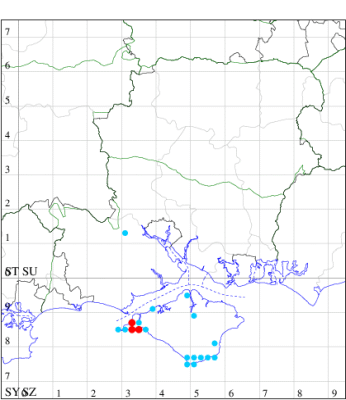
Records by year
Records by week (adult)
Records by week (larval)
Record Details
VC10: West High Down quarries, one, trapped by James Halsey, 16 Aug (IOu); Totland, one, 23 Sep (RTer); Freshwater Bay, one, 21 Aug (SDav); one, 15 Sep (PBar)
73.313 [B&F: 2081] White-line Dart Euxoa tritici (Linnaeus, 1761) - Common
Common on sand-dunes, sea cliffs, heathland, moorland and downland throughout much of the British Isles, a species of conservation concern under the UK Biodiversity Action Plan. In Hampshire and on the Isle of Wight found primarily on the sandy coasts of vice-counties 10 and 11, with a smaller, darker form frequent on the heaths of the New Forest and north-eastern Hampshire; rare elsewhere. Wingspan 28-40 mm. The most likely confusion species are Square-spot Dart E. obelisca and Coast Dart E. cursoria, which see for differences. Larva feeds on various herbaceous plants, including Common Mouse-ear, Common Chickweed, Greater Stitchwort and Hedge Bedstraw, over-wintering as an egg or small larva.
Records prior to 2022
| Vice County | #Records | #Individuals | First Record | Last Record |
|---|---|---|---|---|
| 10 | 29 | 7 | 1856 | 2011 |
| 11 | 714 | 3593 | 1951 | 2021 |
| 12 | 79 | 68 | 1951 | 2021 |
2022 records
| Vice County | #Records | #Individuals | Max Quantity |
|---|---|---|---|
| 11 | 41 | 216 | 30 |
| 12 | 7 | 13 | 6 |
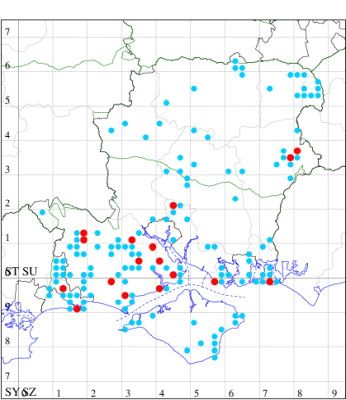
Records by year
Records by week (adult)
Records by week (larval)
Record Details
VC11: Ogden's Purlieu, NF, one, 18 Jul; Hasley, NF, present, 19 Jul (AMD); Pig Bush, NF, one, 09 Aug (NRJ); Marchwood, one, 04 Aug (CTha); Woodlands, NF, one, 06 Aug (CJon); Dibden Purlieu, two, 30 Jul; one, 31 Jul; one, 08 Aug; one, 20 Sep; one, 21 Sep; one, 22 Sep (RAC); Blackfield, one, 06 Aug (SJJ); Allbrook, one, 26 Jul (SIng); Hurn, one, 15 Aug; Hengistbury Head, four, 01 Aug; eight, 11 Jul; three, 18 Jul; seven, 19 Jul; 15, 20 Jul; five, 26 Jul; two, 27 Jul (MJef); two, 01 Aug; two, 08 Aug; two, 14 Aug (RPH det. MJef); Sway, NF, present, 06 Aug (DMui); Pennington, one, 27 Jul (RFC); Needs Ore NNR, two, 05 Aug; 30, 05 Aug; 30, 11 Aug; one, 14 Jul; five, 21 Jul; 15, 23 Jul; 10, 25 Jul; 13, 28 Jul; six, 06 Aug; 22, 13 Aug; one, 19 Aug; four, 17 Jul; one, 29 Jul (CNB); Browndown Coastal Ranges, 10, 12 Aug (KCok, RJD, MLO, ADT, DWal det. KJW); Hayling Island, one, 19 Jul (STho);
VC12: Whitehill, one, 20 Jul; one, 25 Jul; one, 29 Jul; two, 31 Jul; one, 03 Aug; one, 05 Aug (ASto); Broxhead Common, six, 04 Aug (KBW, HthRT det. KBW)
73.314 [B&F: 2082] Garden Dart Euxoa nigricans (Linnaeus, 1761) - Common
Local in gardens, allotments and farmland, and on downland and rough ground throughout the British Isles, a species of conservation concern under the UK Biodiversity Action Plan. In Hampshire and on the Isle of Wight there are still scattered records, but numbers have declined drastically recently, and records will no longer be accepted without convincing evidence. Wingspan 32-40 mm. Some forms can be confused with White-line Dart E. tritici, but that is a neater, more sharply marked insect; the presence of the claviform stigma, as well as the relatively longer and narrower forewing, should preclude confusion with Square-spot Rustic Xestia xanthographa (MBGBI Vol 9). Larva feeds on various herbaceous plants, including Clover, Dock and Plantain, over-wintering as an egg or small larva.
Records prior to 2022
| Vice County | #Records | #Individuals | First Record | Last Record |
|---|---|---|---|---|
| 10 | 12 | 3 | 1968 | 1997 |
| 11 | 153 | 133 | 1949 | 2019 |
| 12 | 85 | 57 | 1951 | 2021 |
2022 records
| Vice County | #Records | #Individuals | Max Quantity |
|---|---|---|---|
| 11 | 1 | 1 | 1 |
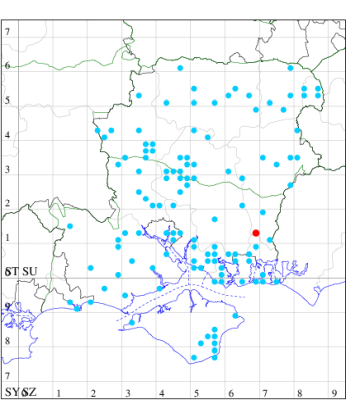
Records by year
Records by week (adult)
Records by week (larval)
Record Details
VC11: Lovedean, one, 23 Jul (ARJ)
73.316 [B&F: 2084] Light Feathered Rustic Agrotis cinerea ([Denis & Schiffermüller], 1775) - Nationally Scarce
Nationally scarce (Nb) on calcareous grassland, quarries, sea cliffs and shingle beaches in parts of England. In Hampshire and on the Isle of Wight it still occurs on the chalk downland of the Island and along the boundary between vice-counties 11 and 12, and also on Portsdown Hill above Portsmouth, but is much less common than formerly. Wingspan 33-40 mm. Distinguished from all other Agrostis species by the dentate ante- and post-median fasciae and inconspicuous stigmata. Larva feeds on Wild Thyme.
Records prior to 2022
| Vice County | #Records | #Individuals | First Record | Last Record |
|---|---|---|---|---|
| 10 | 45 | 19 | 1800 | 2021 |
| 11 | 66 | 78 | 1800 | 2019 |
| 12 | 46 | 105 | 1900 | 2016 |
2022 records
| Vice County | #Records | #Individuals | Max Quantity |
|---|---|---|---|
| 10 | 2 | 2 | 1 |
| 11 | 1 | 1 | 1 |
| 12 | 1 | 1 | 1 |
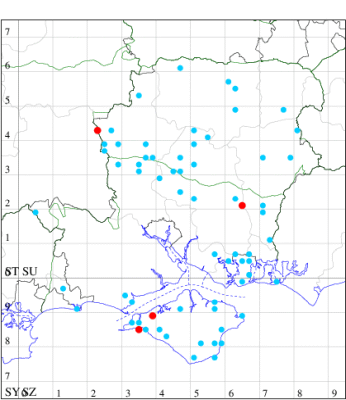
Records by year
Records by week (adult)
Records by week (larval)
Record Details
VC10: Freshwater Bay, one, 08 May (SDav); Cranmore, one, 10 May (JMar, JRB et al);
VC11: Old Winchester Hill, one, male, 27 May (RJD, MLO, ADT & DWal det. RJD);
VC12: Cholderton, one, 01 Jul (TJN)
73.317 [B&F: 2089] Heart & Dart Agrotis exclamationis (Linnaeus, 1758) - Common
Common often abundant, in all types of habitat throughout the British Isles. Widespread and very common in Hampshire and on the Isle of Wight. Wingspan 35-44 mm. The presence of the dark mark on the patagia distinguishes Heart and Dart from the occasional female Heart and Club A. clavis which resembles it (MBGBI Vol 9). Larva feeds on herbaceous plants such as Ribwort Plantain and Fat-hen.
Records prior to 2022
| Vice County | #Records | #Individuals | First Record | Last Record |
|---|---|---|---|---|
| 10 | 2377 | 28080 | 1951 | 2021 |
| 11 | 24355 | 232854 | 1951 | 2021 |
| 12 | 6667 | 59208 | 1900 | 2021 |
2022 records
| Vice County | #Records | #Individuals | Max Quantity |
|---|---|---|---|
| 10 | 255 | 1198 | 29 |
| 11 | 987 | 3063 | 28 |
| 12 | 289 | 1093 | 31 |
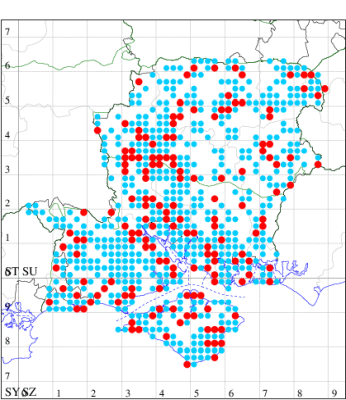
Records by year
Records by week (adult)
Records by week (larval)
Record Summary
VC10: Earliest: West High Down quarries, 12 Jul, 10 (IOu) Latest: Upper Green, 11 Aug, 1 (SHug) Max count: Newport, 02 Jun, 29 (DPl)
VC11: Earliest: Brockwood, 05 Jun, 1 (SDut) Latest: Hayling Island, 22 Jul, 3 (STho) Max count: Portsmouth, 09 Jun, 28 (IRT)
VC12: Earliest: Cholderton, 01 Jul, 7 (TJN) Latest: Farnborough, 08 Jul, 2 (SBly) Max count: Basingstoke, 19 Jun, 31 (MJW)
73.319 [B&F: 2087] Turnip Moth Agrotis segetum ([Denis & Schiffermüller], 1775) - Common
Common in gardens, farmland, parkland, oak woodland and sand-dunes throughout the British Isles. Widespread and common in Hampshire and on the Isle of Wight. Wingspan 32-42 mm. Underwing pearly white with darker veins, suffused grey in dark examples, a feature shared amongst its congeners only by the larger Pearly Underwing Peridroma saucia and Dark Sword-grass A. ipsilon, which see. Larva feeds on roots and lower stems of cabbages and various root crops, causing sufficient damage to be a serious pest in some areas.
Records prior to 2022
| Vice County | #Records | #Individuals | First Record | Last Record |
|---|---|---|---|---|
| 10 | 439 | 658 | 1951 | 2021 |
| 11 | 6281 | 8436 | 200 | 2021 |
| 12 | 1503 | 2184 | 1951 | 2021 |
2022 records
| Vice County | #Records | #Individuals | Max Quantity |
|---|---|---|---|
| 10 | 65 | 81 | 4 |
| 11 | 594 | 982 | 16 |
| 12 | 139 | 239 | 11 |
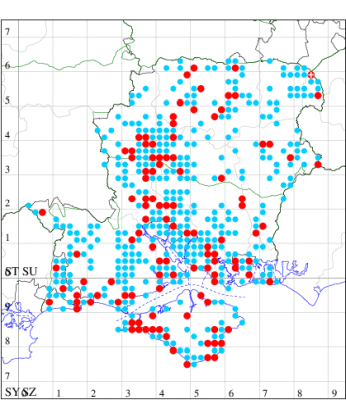
Records by year
Records by week (adult)
Records by week (larval)
Record Summary
VC10: Earliest: Tennyson Down, 18 Sep, 1 (PBar) Latest: Sandown, 20 Aug, 0 (SPee) Max count: St. Catherine's Point, 11 Oct, 4 (IOu)
VC11: Earliest: Brockwood, 02 Jul, 1 (SDut) Latest: Hayling Island, 04 Aug, 1 (STho) Max count: Fareham, 13 Nov, 16 (MLO)
VC12: Earliest: Nether Wallop, 02 Sep, 1 (GCE) Latest: Farnborough, 03 Oct, 2 (KBW) Max count: Basingstoke, 14 Aug, 11 (MJW)
73.320 [B&F: 2088] Heart & Club Agrotis clavis (Hufnagel, 1766) - Common
Common on chalk downland, dry open areas and gardens, and in coastal sand-dunes throughout much of England and Wales. In Hampshire and on the Isle of Wight fairly common, although not as much so as the closely related Heart & Dart, mainly on the coast and on the chalk. Wingspan 35-40 mm. The main confusion species is Heart & Dart A. exclamationis, which has a characteristic dark mark on the patagia, lacking in Heart & Club. Larva feeds on various herbaceous plants, including Broad-leaved Dock, Wild Carrot and Fat-hen.
Records prior to 2022
| Vice County | #Records | #Individuals | First Record | Last Record |
|---|---|---|---|---|
| 10 | 753 | 3263 | 1981 | 2021 |
| 11 | 6949 | 16302 | 1949 | 2021 |
| 12 | 2488 | 9114 | 1951 | 2021 |
2022 records
| Vice County | #Records | #Individuals | Max Quantity |
|---|---|---|---|
| 10 | 84 | 215 | 11 |
| 11 | 273 | 475 | 10 |
| 12 | 124 | 292 | 14 |
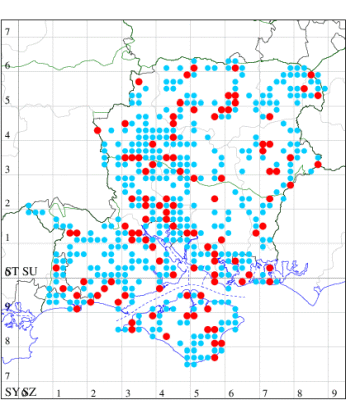
Records by year
Records by week (adult)
Records by week (larval)
Record Summary
VC10: Earliest: West High Down quarries, 12 Jul, 5 (IOu) Latest: Wootton Bridge, 29 Jun, 1 (DElm) Max count: Brighstone, 18 Jun, 11 (AMas)
VC11: Earliest: Brockwood, 12 Jun, 6 (SDut) Latest: Hayling Island, 25 Jun, 1 (STho) Max count: The Glen, Frogham, 04 Jun, 10 (DBra)
VC12: Earliest: Cholderton, 01 Jul, 14 (TJN) Latest: Farnborough, 06 Jul, 3 (KBW) Max count: Cholderton, 01 Jul, 14 (TJN)
73.322 [B&F: 2085] Archer's Dart Agrotis vestigialis (Hufnagel, 1766) - Local
Local on sand-dunes, all around the coasts of the British Isles, and on heaths inland in southern England. In Hampshire frequent on the sand-dunes of Hayling Island, less so in other coastal localities; still found in small numbers in the New Forest and on the eastern heaths of North Hampshire. There have only been three recent record from the Isle of Wight, in 1995, 2011 and 2013. Wingspan 30-40 mm. The most distinctive and easily recognised of the Agrostis species. Larva feeds on herbaceous plants such as Lady's Bedstraw, Hedge Bedstraw, Heath Bedstraw and Greater Stitchwort.
Records prior to 2022
| Vice County | #Records | #Individuals | First Record | Last Record |
|---|---|---|---|---|
| 10 | 10 | 2 | 1909 | 2013 |
| 11 | 150 | 237 | 1949 | 2021 |
| 12 | 38 | 48 | 1951 | 2021 |
2022 records
| Vice County | #Records | #Individuals | Max Quantity |
|---|---|---|---|
| 11 | 1 | 1 | 1 |
| 12 | 1 | 3 | 3 |
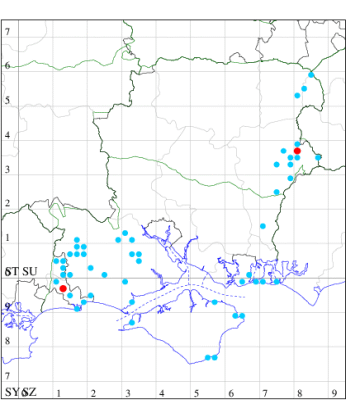
Records by year
Records by week (adult)
Records by week (larval)
Record Details
VC11: Hurn, one, 03 Sep (MJef);
VC12: Broxhead Common, three, 04 Aug (KBW, HthRT det. KBW)
73.323 [B&F: 2093] Sand Dart Agrotis ripae (Hübner, [1823]) - Nationally Scarce
Nationally scarce (Nb) on sandy beaches, on the coasts of England and Wales, east Scotland, Jersey, Alderney and the Isle of Man; it also occurs on the east and south coasts of Ireland. In Hampshire and on the Isle of Wight common on the dunes of Hayling Island and Hengistbury on the mainland, and at Bembridge and St Helens on the Island. Wingspan 32-42 mm. The most likely confusion species is Coast Dart Euxoa cursoria, which usually emerges several weeks later than Sand Dart, differs in having a longer, narrower forewing, and the space between the reniform stigma and the dorsum is only slightly greater than the depth of the reniform stigma itself, whereas in Sand Dart it is about twice that depth (MBGBI Vol 9). Confusion is also possible with Sandhill Rustic Luperina nickerlii, but that has a chequered fringe on the forewing, a white-edged reniform stigma and clearer, pale, dark-edged cross-lines (MBGBI Vol 10). Larva feeds on herbaceous plants, over-wintering in a cocoon.
Records prior to 2022
| Vice County | #Records | #Individuals | First Record | Last Record |
|---|---|---|---|---|
| 10 | 25 | 9 | 1856 | 2019 |
| 11 | 115 | 194 | 1800 | 2015 |
2022 records
| Vice County | #Records | #Individuals | Max Quantity |
|---|---|---|---|
| 11 | 2 | 9 | 8 |
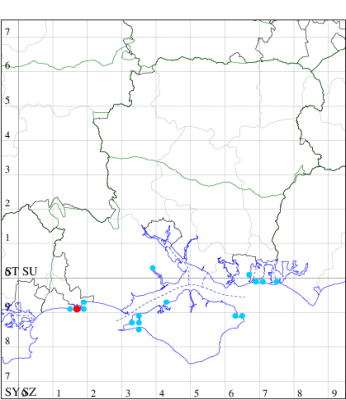
Records by year
Records by week (adult)
Records by week (larval)
Record Details
VC11: Hengistbury Head, one, 17 Jun; eight, 14 Jun (MJef)
73.324 [B&F: 2090] Crescent Dart Agrotis trux (Hübner, [1824]) - Local
Local on sea cliffs and rocky areas by the sea, from the Isle of Wight westwards to north Wales. In Hampshire and on the Isle of Wight found mainly on the coasts of the Island, where it is locally common. Very rare on the mainland, but occasional wanderers have been found some distance inland. Wingspan 35-42 mm. Quite variable, with specimens from the Isle of Wight larger and paler than elsewhere in Britain; resembles Turnip Moth A. segetum and Heart and Club A. clavis, as well as the rare immigrant Great Dart A. crassa. Larva feeds on Rock Sea-spurrey and Thrift.
Records prior to 2022
| Vice County | #Records | #Individuals | First Record | Last Record |
|---|---|---|---|---|
| 10 | 413 | 1353 | 1856 | 2021 |
| 11 | 20 | 15 | 1974 | 2021 |
| 12 | 1 | 1 | 1962 | 1962 |
2022 records
| Vice County | #Records | #Individuals | Max Quantity |
|---|---|---|---|
| 10 | 13 | 23 | 5 |
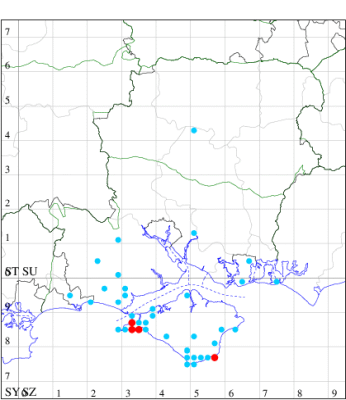
Records by year
Records by week (adult)
Records by week (larval)
Record Details
VC10: West High Down quarries, two, 12 Jul (IOu); Totland, two, 24 Jul; one, 25 Jul; one, 27 Jul; one, 30 Jul (RTer); Freshwater Bay, one, 09 Jun; five, 10 Jun; five, 10 Aug (SDav); one, 11 Sep; one, 14 Sep (PBar); Bonchurch, one, 11 Sep; one, 19 Sep; one, 21 Sep (JHa)
73.325 [B&F: 2092] Shuttle-shaped Dart Agrotis puta (Hübner, [1803]) - Local
Common often abundant, in gardens, farmland, grassland, heathland and open woodland throughout England and Wales. Widespread and common in Hampshire and on the Isle of Wight. Wingspan 30-32 mm. Larva feeds on various herbaceous plants, including Dandelion, Knotgrass, and several species of dock.
Records prior to 2022
| Vice County | #Records | #Individuals | First Record | Last Record |
|---|---|---|---|---|
| 10 | 1590 | 4801 | 1951 | 2021 |
| 11 | 25836 | 78716 | 200 | 2021 |
| 12 | 6249 | 22117 | 1951 | 2021 |
2022 records
| Vice County | #Records | #Individuals | Max Quantity |
|---|---|---|---|
| 10 | 268 | 694 | 18 |
| 11 | 1498 | 4290 | 24 |
| 12 | 483 | 1761 | 30 |
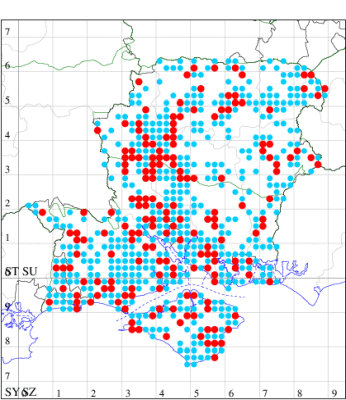
Records by year
Records by week (adult)
Records by week (larval)
Record Summary
VC10: Earliest: Tennyson Down, 18 Sep, 1 (PBar) Latest: Upper Green, 11 Aug, 3 (SHug) Max count: Brighstone, 09 Aug, 18 (TDov)
VC11: Earliest: Brockwood, 14 Aug, 2 (SDut) Latest: Hayling Island, 04 Aug, 2 (STho) Max count: Marchwood, 09 May, 24 (CTha)
VC12: Earliest: Cholderton, 19 Jul, 0 (TJN) Latest: Farnborough, 07 May, 3 (SBly) Max count: Tidgrove Warren, nr Overton, 23 Jul, 30 (MJW, ACB)
73.327 [B&F: 2091] Dark Sword-grass Agrotis ipsilon (Hufnagel, 1766) - Migrant
Common immigrant from mainland Europe, appearing throughout the British Isles, in some years arriving in sufficient numbers to breed in small numbers. In Hampshire and on the Isle of Wight a common immigrant, which is widely distributed throughout in some years. Wingspan 40-55 mm. Has a distinctive set of arrow-shaped darts, one pointing outwards from the reniform stigma, with two smaller ones facing inwards near the margin. Larva feeds on various herbaceous plants, but unable to over-winter in significant numbers.
Records prior to 2022
| Vice County | #Records | #Individuals | First Record | Last Record |
|---|---|---|---|---|
| 10 | 674 | 1590 | 1951 | 2021 |
| 11 | 3753 | 5101 | 1949 | 2021 |
| 12 | 650 | 768 | 1949 | 2021 |
2022 records
| Vice County | #Records | #Individuals | Max Quantity |
|---|---|---|---|
| 10 | 49 | 59 | 3 |
| 11 | 122 | 153 | 5 |
| 12 | 55 | 73 | 3 |
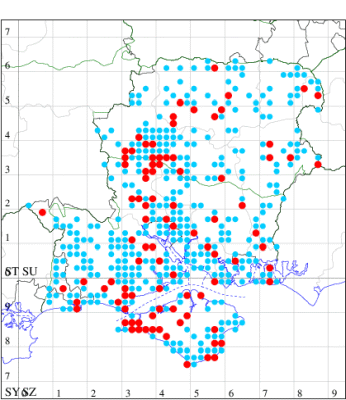
Records by year
Records by week (adult)
Records by week (larval)
Record Summary
VC10: Earliest: Headon Warren, 23 Apr, 1 (PBar) Latest: Osborne Wood, 13 Aug, 1 (IOu) Max count: Freshwater Bay, 10 Aug, 3 (SDav)
VC11: Earliest: Pig Bush, NF, 23 Aug, 2 (NRJ) Latest: Hayling Island, 01 Sep, 1 (STho) Max count: Botley, 12 Aug, 5 (SLB)
VC12: Earliest: Nether Wallop, 17 May, 1 (GCE) Latest: Farnborough, 12 Aug, 1 (KBW) Max count: Chilbolton, 31 Jul, 3 (GCE)
73.328 [B&F: 2098] Flame Axylia putris (Linnaeus, 1761) - Common
Common on farmland, downland and heathland, and in hedgerows, woodland edges and gardens throughout the British Isles. Widespread and common in Hampshire and on the Isle of Wight. Wingspan 30-38 mm. Larva feeds on a variety of herbaceous plants, including Stinging Nettle, White Dead-nettle, Hedge Bedstraw, Hound's-tongue, over-wintering as a pupa.
Records prior to 2022
| Vice County | #Records | #Individuals | First Record | Last Record |
|---|---|---|---|---|
| 10 | 946 | 4077 | 1951 | 2021 |
| 11 | 7250 | 16363 | 1951 | 2021 |
| 12 | 2775 | 8703 | 1948 | 2021 |
2022 records
| Vice County | #Records | #Individuals | Max Quantity |
|---|---|---|---|
| 10 | 101 | 310 | 19 |
| 11 | 243 | 393 | 32 |
| 12 | 119 | 233 | 10 |
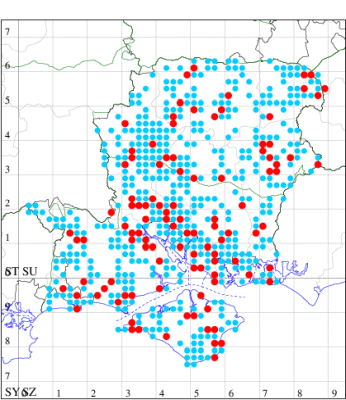
Records by year
Records by week (adult)
Records by week (larval)
Record Summary
VC10: Earliest: West High Down quarries, 12 Jul, 5 (IOu) Latest: Sandpit Copse, 20 May, 1 (IOu) Max count: Shanklin, 17 Jun, 19 (IOu)
VC11: Earliest: Fordingbridge, 17 Jun, 4 (SCT) Latest: Hayling Island, 12 Jul, 1 (STho) Max count: Needs Ore NNR, 18 Jun, 32 (CNB)
VC12: Earliest: Broughton, 21 Jun, 2 (GCE) Latest: Farnborough, 08 Jul, 2 (SBly) Max count: Whitehill, 16 Jun, 10 (ASto)
73.329 [B&F: 2102] Flame Shoulder Ochropleura plecta (Linnaeus, 1761) - Common
Common in a wide variety of habitats, from gardens to wetlands throughout the British Isles. Widespread and common in Hampshire and on the Isle of Wight. Wingspan 28-34 mm. Could be confused with the much rarer Radford's Flame Shoulder O. leucogaster, which see. Larva feeds on various herbaceous plants, including Groundsel, Ribwort Plantain, Lady's Bedstraw, Hedge Bedstraw and Heath Bedstraw, over-wintering as a pupa.
Records prior to 2022
| Vice County | #Records | #Individuals | First Record | Last Record |
|---|---|---|---|---|
| 10 | 1948 | 6772 | 1951 | 2021 |
| 11 | 21553 | 60769 | 200 | 2021 |
| 12 | 6431 | 23636 | 1951 | 2021 |
2022 records
| Vice County | #Records | #Individuals | Max Quantity |
|---|---|---|---|
| 10 | 308 | 1168 | 48 |
| 11 | 1144 | 2874 | 38 |
| 12 | 458 | 1231 | 28 |
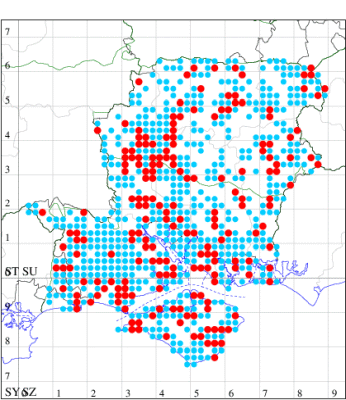
Records by year
Records by week (adult)
Records by week (larval)
Record Summary
VC10: Earliest: Tennyson Down, 20 Sep, 1 (PBar) Latest: Upper Green, 11 Aug, 1 (SHug) Max count: Sandown, 29 Jul, 48 (IOu)
VC11: Earliest: Brockwood, 16 Jul, 1 (SDut) Latest: Hayling Island, 04 Aug, 2 (STho) Max count: Needs Ore NNR, 13 Aug, 38 (CNB)
VC12: Earliest: Cholderton, 19 Jul, 0 (TJN) Latest: Blackwater, 13 Jul, 15 (BGD) Max count: Chawton, 04 Aug, 28 (DAS)
73.330 [B&F: 2102a] Radford's Flame Shoulder Ochropleura leucogaster (Freyer, [1831]) - Vagrant/Accidental
Rare immigrant from southern Europe, appearing in southern England. In Hampshire and on the Isle of Wight first recorded at Lepe on the mainland in October 2006 and at Ventnor on the Island in September 2008. From 2015 it has been reported annually, particularly on the island, and 2021 saw a record 42 individuals.
Wingspan 34-37 mm. Resembles Flame Shoulder O. plecta but the forewings are proportionately longer and paler than in O. plecta with an indistinct line of subterminal spots. O. leucogaster has smaller orbicular and reniform stigmata, straighter and more compact 'flame shoulder' running along the upper edge of the forewing to just beyond the reniform stigma, much purer white and larger hindwings with a whitish fringe. The deeply coloured maroon metathorax contrasts sharply with the silky white hairs which cover the anterior abdominal segments and contrast strongly with the dark red thoracic hairs. The abdomen itself is very pale brown, unlike the darker earth-brown colour of O. plecta (MBGBI Vol 9). Larva feeds on Common Bird's-foot Trefoil, no evidence of breeding in the UK.
Records prior to 2022
| Vice County | #Records | #Individuals | First Record | Last Record |
|---|---|---|---|---|
| 10 | 73 | 114 | 2008 | 2021 |
| 11 | 16 | 14 | 2006 | 2021 |
2022 records
| Vice County | #Records | #Individuals | Max Quantity |
|---|---|---|---|
| 10 | 8 | 8 | 1 |
| 11 | 1 | 1 | 1 |
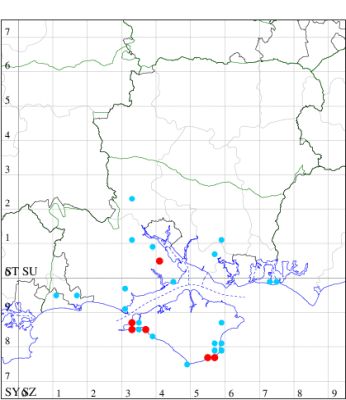
Records by year
Records by week (adult)
Records by week (larval)
Record Details
VC10: West High Down quarries, one, 22 Sep (MGT det. JHa); one, 22 Sep (IOu); Totland, one, 24 Sep (RTer); Compton Down, one, 11 Sep (PBar); Ventnor, one, 12 Nov; one, same individual from previous night, re-trapped, 13 Nov (MGT); Bonchurch, one, 05 Sep; one, 07 Sep (JHa);
VC11: Dibden Purlieu*, one, 27 Oct (RAC)
73.332 [B&F: 2122] Purple Clay Diarsia brunnea ([Denis & Schiffermüller], 1775) - Common
Common in broad-leaved woodland and wooded heathland throughout much of the British Isles. In Hampshire and on the Isle of Wight much less common than formerly; in the summer of 1892, for instance, at Brockenhurst it was stated to be a continual pest at sugar. It occurs in deciduous woodland, and nowadays it is usually recorded as single specimens. Wingspan 36-45 mm. Distinguished from female Barred Chestnut D. dahlii by the darker wavy band between the postmedian and subterminal lines, the absence of the pale subterminal line which is characteristic of that species, and the blacker quadrate mark between the reniform and orbicular stigmata. Pale individuals could be mistaken for northern Ingrailed Clay D. mendica, but these are often more extensively orange-tinted and marbled, and slightly smaller (MBGBI Vol 9). Larva feeds on Foxglove, Bilberry, Heather, Sallow, Bramble, Silver Birch and Downy Birch.
Records prior to 2022
| Vice County | #Records | #Individuals | First Record | Last Record |
|---|---|---|---|---|
| 10 | 65 | 82 | 1892 | 2021 |
| 11 | 935 | 1054 | 1951 | 2021 |
| 12 | 392 | 457 | 1951 | 2021 |
2022 records
| Vice County | #Records | #Individuals | Max Quantity |
|---|---|---|---|
| 10 | 8 | 11 | 2 |
| 11 | 20 | 23 | 3 |
| 12 | 18 | 18 | 1 |
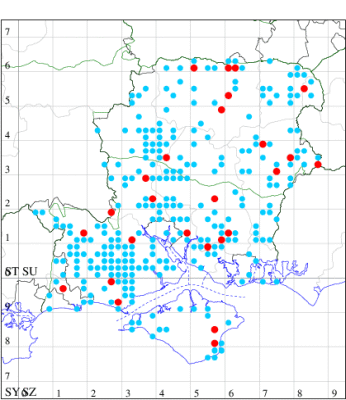
Records by year
Records by week (adult)
Records by week (larval)
Record Details
VC10: Alverstone, one, 03 Jul (GBro); Shanklin, two, 16 Jun; one, 17 Jun; two, 22 Jun; one, 30 Jun; two, 06 Jul; one, 08 Jul (IOu); Alverstone, one, 12 Jul (DFai);
VC11: Hasley, NF, present, 19 Jul (AMD); Plaitford Common, one, 09 Jul (NBin); Woodlands, NF, one, 17 Jun (CJon); Ashley, one, 11 Jul (GCE); Romsey, one, 08 Jun; one, 08 Jul (NRJ); Botley Wood, three, 01 Jul (DWal, KJW); Funtley, one, 20 Jun (TDC); Wickham, one, 09 Jun; one, 16 Jun; one, 20 Jun; one, 23 Jun; one, 27 Jun (JRDS); Upham, one, 01 Jul (PAB, KCok & RJD); West Walk, three, 10 Jun (RJD, MLO & KJW); Hurn, one, 25 Jul; one, 26 Jul; one, 02 Aug (MJef); Sway, one, 09 Jul (SKee); Milford on Sea, one, 16 Jun (MMcM);
VC12: Grayshott, one, 15 Jun (THard); Crawley, one, 09 Jul (GCE); Basingstoke, one, 17 Jun; one, 21 Jun; one, 12 Aug (GAH); Ecchinswell, one, 06 Jul (MJN); Basingstoke, one, 21 Jun (MJW); Pamber Forest, one, 11 Jul; one, 09 Jun; one, 21 Jun (GJD); Whitedown, Alton, one, 03 Jun (BCA); Noar Hill HIWWT NR, Selborne, one, 08 Jul (IBla); Whitehill, one, 17 Jun; one, 02 Jul (ASto); Hammer Vale, Woolmer, one, 02 Jul; one, 07 Jul; one, 09 Jul (ASwa); Fleet Pond, one, 06 Jul (MHals)
73.333 [B&F: 2120] Ingrailed Clay Diarsia mendica (Fabricius, 1775) - Local
Common in woodland, gardens and heathland throughout the British Isles. Widespread and common in Hampshire and on the Isle of Wight. Wingspan 28-36 mm. Very variable, and can be confused with a number of other species, but general pattern sufficiently distinct to enable identification in most cases; a useful field mark, sometimes absent, is the small black dot between the orbicular stigma and dorsum, a feature shared by the superficially similar Small Square-spot D. rubi. Larva feeds on Primrose, Hawthorn, Hazel, Blackthorn and other woody plants.
Records prior to 2022
| Vice County | #Records | #Individuals | First Record | Last Record |
|---|---|---|---|---|
| 10 | 734 | 2078 | 1981 | 2021 |
| 11 | 3101 | 6385 | 1948 | 2021 |
| 12 | 1548 | 3404 | 1951 | 2021 |
2022 records
| Vice County | #Records | #Individuals | Max Quantity |
|---|---|---|---|
| 10 | 26 | 57 | 8 |
| 11 | 103 | 245 | 13 |
| 12 | 65 | 107 | 5 |
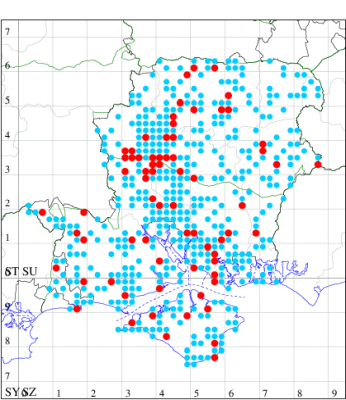
Records by year
Records by week (adult)
Records by week (larval)
Record Summary
VC10: Earliest: Totland, 31 May, 2 (RTer) Latest: Firestone Copse, 21 Jun, 3 (IOu) Max count: Shanklin, 08 Jun, 8 (IOu)
VC11: Earliest: Brockwood, 12 Jun, 4 (SDut) Latest: Browndown Coastal Ranges, 03 Jun, 1 (RJD, MLO, ADT, DWal & KJW) Max count: West Walk, 10 Jun, 13 (RJD, MLO & KJW)
VC12: Earliest: Nether Wallop, 06 Jun, 1 (GCE) Latest: Hammer Vale, Woolmer, 14 Jun, 1 (ASwa) Max count: Broughton, 02 Jun, 5 (GCE)
73.334 [B&F: 2123] Small Square-spot Diarsia rubi (Vieweg, 1790) - Common
Common in damp woodland and grassland, gardens and rough meadows throughout the British Isles, a species of conservation concern under the UK Biodiversity Action Plan. Widespread and common in Hampshire and on the Isle of Wight. Wingspan 30-38 mm. A useful field mark is the very small black dot between the orbicular stigma and dorsum, but there is no reliable way to distinguish this species from Fen Square-spot D. florida, and the two taxa may best be considered conspecific. Larva feeds on various herbaceous plants, including Dandelion and Dock.
Records prior to 2022
| Vice County | #Records | #Individuals | First Record | Last Record |
|---|---|---|---|---|
| 10 | 578 | 1924 | 1959 | 2021 |
| 11 | 6538 | 16896 | 1947 | 2021 |
| 12 | 2198 | 8481 | 1950 | 2021 |
2022 records
| Vice County | #Records | #Individuals | Max Quantity |
|---|---|---|---|
| 10 | 135 | 504 | 22 |
| 11 | 573 | 1783 | 35 |
| 12 | 261 | 974 | 31 |
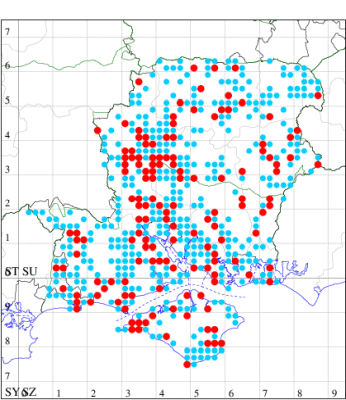
Records by year
Records by week (adult)
Records by week (larval)
Record Summary
VC10: Earliest: Tennyson Down, 15 Sep, 9 (PBar) Latest: Wootton Bridge, 14 Aug, 1 (DElm) Max count: Totland, 03 Jun, 22 (RTer)
VC11: Earliest: Brockwood, 12 Jun, 1 (SDut) Latest: Hayling Island, 17 Jun, 1 (STho) Max count: Crawley, 29 Aug, 35 (GCE)
VC12: Earliest: Cholderton, 11 Sep, 1 (TJN) Latest: Farnborough, 22 Aug, 1 (KBW) Max count: Bullington, 22 Aug, 31 (GCE)
73.336 [B&F: 2139] Red Chestnut Cerastis rubricosa ([Denis & Schiffermüller], 1775) - Common
Common in broad-leaved woodland, scrub, gardens and moorland throughout the British Isles. Widespread and still reasonably common in Hampshire and on the Isle of Wight. Wingspan 32-38 mm. Straight costa and spring emergence eliminates all but White-marked C. leucographa, which differs most obviously in pale orbicular and reniform stigmata. Larva feeds on various herbaceous and woody plants, over-wintering as a pupa.
Records prior to 2022
| Vice County | #Records | #Individuals | First Record | Last Record |
|---|---|---|---|---|
| 10 | 73 | 67 | 1951 | 2021 |
| 11 | 1320 | 2430 | 1951 | 2021 |
| 12 | 226 | 284 | 1951 | 2020 |
2022 records
| Vice County | #Records | #Individuals | Max Quantity |
|---|---|---|---|
| 10 | 8 | 13 | 3 |
| 11 | 44 | 134 | 11 |
| 12 | 13 | 21 | 6 |
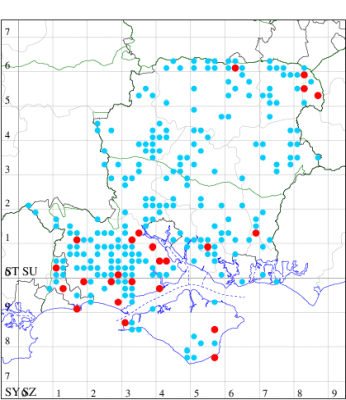
Records by year
Records by week (adult)
Records by week (larval)
Record Details
VC10: Headon Warren, two, 23 Apr (PBar); Bonchurch, three, 21 Mar; one, 23 Mar; one, 28 Mar; two, 29 Mar; two, 16 Apr (JHa); Alverstone, one, 22 Mar; one, 28 Mar (DFai);
VC11: Brockwood, one, 15 Apr (SDut); Furzehill, NF, two, 22 Apr; two, 03 May; two, 28 Mar; 11, 17 Apr; four, 30 Apr (SLoa); Brockenhurst, two, 03 Apr; two, 04 Apr; two, 05 Apr (TBla); Marchwood, one, 15 Mar (CTha); Woodlands, NF, present, 29 Mar (RBW); Totton, one, 22 Apr (LHan); Dibden Purlieu, two, 21 Apr (RAC); Buttsash, Hythe, two, 24 Apr (JBl); Botley Wood, three, 18 Mar (RJD, MLO, ADT, DWal, KJW); Lovedean, one, 24 Mar (ARJ); Hurn, one, 09 Apr; one, 01 May (MJef); Hengistbury Head, two, 18 Mar; one, 19 Mar; three, 20 Mar; two, 21 Mar; five, 22 Mar; two, 23 Mar; eight, 24 Mar; eight, 30 Mar; six, 31 Mar; three, 01 Apr; three, 06 Apr; 10, 07 Apr; four, 08 Apr; three, 12 Apr; seven, 18 Apr; five, 19 Apr; six, 20 Apr; three, 21 Apr (BCP Ran.); three, 25 Apr (BKin); four, 26 Apr (BCP Ran.); two, 05 May (HHug); Thorney Hill, Bransgore, one, 23 Apr (JFen); Sway, NF, present, 23 Apr (DMui); Milford on Sea, one, 04 Apr (MMcM); Pilley, one, 09 Apr (ChCor); Needs Ore NNR*, one, 05 May (CNB);
VC12: Pamber Forest, one, 28 Mar; one, 11 Apr; one, 27 Apr (GJD); Yateley Common, two, 28 Mar; one, 15 Apr (BGD); Fleet Pond, one, 28 Mar (MHals); Yateley Common, one, at dusk, 21 Mar; one, 28 Mar; three, 15 Apr; six, 30 Apr; one, 05 Apr; one, at dusk, 05 Apr (BGD); Farnborough, one, 03 May (KBW)
73.337 [B&F: 2140] White-marked Cerastis leucographa ([Denis & Schiffermüller], 1775) - Local
Local in broad-leaved woodland, mature hedgerows and scrub, discontinuously in England from Kent to Yorkshire. In Hampshire nearly all records are from the north, where it has been found in scattered locations, with exceptionally stragglers reported in the south. Not recorded from the Isle of Wight to date. Wingspan 35-39 mm. Differs from Red Chestnut C. rubricosa as follows: antenna in male more strongly pectinate; forewing duller and more strongly marked, particularly the pale stigmata; hindwing paler (MBGBI Vol 9). Larva feeds on various herbaceous and woody plants, over-wintering as a pupa.
Records prior to 2022
| Vice County | #Records | #Individuals | First Record | Last Record |
|---|---|---|---|---|
| 11 | 7 | 8 | 1974 | 2014 |
| 12 | 122 | 146 | 1951 | 2020 |
2022 records
| Vice County | #Records | #Individuals | Max Quantity |
|---|---|---|---|
| 12 | 10 | 9 | 2 |
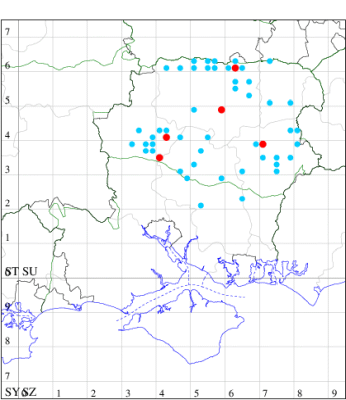
Records by year
Records by week (adult)
Records by week (larval)
Record Details
VC12: Crawley, one, 26 Mar; Barton Stacey, one, 09 May (GCE); Basingstoke, one, 24 Mar; one, 28 Mar (GAH); Pamber Forest, one, 06 Apr; two, 11 Apr; one, 27 Apr; present, 27 Apr (GJD); Whitedown, Alton, present, 05 Apr; Alton, one, 05 Apr (BCA det. MJW)
73.338 [B&F: 2118] True Lover's Knot Lycophotia porphyrea ([Denis & Schiffermüller], 1775) - Common
Common on heathland, moorland and in gardens where heather is grown throughout the British Isles; very common on the heaths of Hampshire and the Isle of Wight and increasingly recorded from gardens containing heather. Wingspan 26-34 mm. Unmistakable. Larva feeds on Heather and Bell Heather.
Records prior to 2022
| Vice County | #Records | #Individuals | First Record | Last Record |
|---|---|---|---|---|
| 10 | 267 | 587 | 1900 | 2021 |
| 11 | 3896 | 14807 | 1951 | 2021 |
| 12 | 732 | 3290 | 1951 | 2021 |
2022 records
| Vice County | #Records | #Individuals | Max Quantity |
|---|---|---|---|
| 10 | 10 | 13 | 5 |
| 11 | 156 | 338 | 25 |
| 12 | 52 | 255 | 25 |
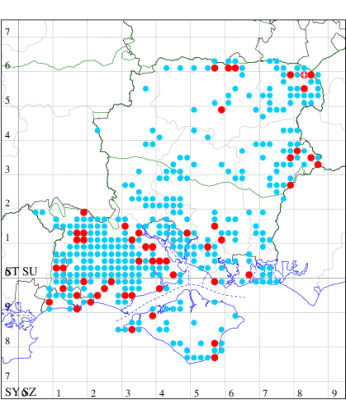
Records by year
Records by week (adult)
Records by week (larval)
Record Summary
VC10: Earliest: West High Down quarries, 12 Jul, 5 (IOu) Latest: Shanklin, 08 Jul, 1 (IOu) Max count: West High Down quarries, 12 Jul, 5 (IOu)
VC11: Earliest: Brockwood, 27 Jun, 1 (SDut) Latest: Browndown Coastal Ranges, 08 Jul, 2 (RJD, ADT, DWal & KJW) Max count: Needs Ore NNR, 10 Jul, 25 (CNB)
VC12: Earliest: Grayshott, 02 Jul, 1 (THard) Latest: Blackwater, 30 Jul, 1 (BGD) Max count: Whitehill, 18 Jul, 25 (ASto)
73.342 [B&F: 2107] Large Yellow Underwing Noctua pronuba (Linnaeus, 1758) - Common
Common often abundant, in a wide range of habitats, including grassland, gardens, woodland and moorland throughout the British Isles. Widespread and extremely common in Hampshire and on the Isle of Wight. Wingspan 50-60 mm. Although variable, with a number of distinct forms, Large Yellow Underwing is usually unmistakable, although a pitfall for the unwary is the assignment of occasional small specimens to the extremely rare and declining Lunar Yellow Underwing N. orbona — both share a small black apical streak, but Large Yellow Underwing lacks the diagnostic black discal spot in the hindwing, which can be seen by gently lifting up the forewing with forceps. Larva feeds various grasses and herbaceous plants.
Records prior to 2022
| Vice County | #Records | #Individuals | First Record | Last Record |
|---|---|---|---|---|
| 10 | 3426 | 30718 | 1951 | 2021 |
| 11 | 36652 | 272320 | 200 | 2021 |
| 12 | 10485 | 121179 | 1948 | 2021 |
2022 records
| Vice County | #Records | #Individuals | Max Quantity |
|---|---|---|---|
| 10 | 306 | 1874 | 45 |
| 11 | 1213 | 4789 | 59 |
| 12 | 544 | 3952 | 97 |
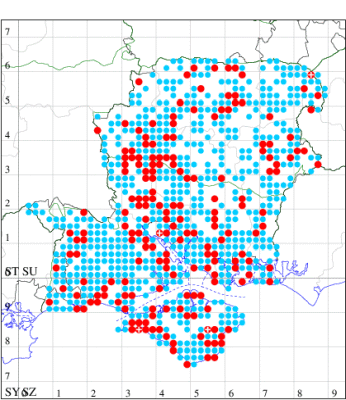
Records by year
Records by week (adult)
Records by week (larval)
Record Summary
VC10: Earliest: Tennyson Down, 15 Sep, 4 (PBar) Latest: Sandown, 29 Jul, 2 (IOu) Max count: Shanklin, 01 Oct, 45 (IOu)
VC11: Earliest: Brockwood, 26 Aug, 2 (SDut) Latest: Hayling Island, 04 Sep, 1 (STho) Max count: Broughton, 02 Sep, 59 (GCE)
VC12: Earliest: Cholderton, 19 Jul, 0 (TJN) Latest: Farnborough, 26 Oct, 2 (KBW) Max count: Cole Henley, 22 Sep, 97 (GCE)
73.343 [B&F: 2110] Broad-bordered Yellow Underwing Noctua fimbriata (Schreber, 1759) - Common
Common in broad-leaved woodland, parkland, heathland and gardens throughout the British Isles. Widespread and fairly common in Hampshire and on the Isle of Wight. Wingspan 50-58 mm. Variable, but unmistakable. Larva feeds on various deciduous trees, including Birch, Sallow and Sycamore.
Records prior to 2022
| Vice County | #Records | #Individuals | First Record | Last Record |
|---|---|---|---|---|
| 10 | 655 | 1192 | 1951 | 2021 |
| 11 | 7810 | 12181 | 1948 | 2021 |
| 12 | 2414 | 4449 | 1948 | 2021 |
2022 records
| Vice County | #Records | #Individuals | Max Quantity |
|---|---|---|---|
| 10 | 62 | 105 | 8 |
| 11 | 289 | 404 | 9 |
| 12 | 175 | 364 | 25 |
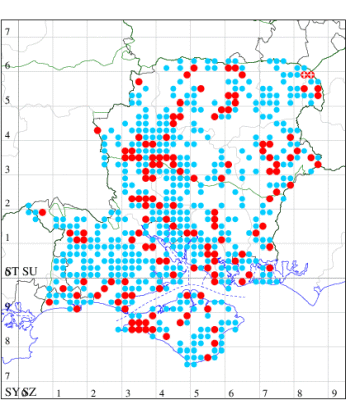
Records by year
Records by week (adult)
Records by week (larval)
Record Summary
VC10: Earliest: Tennyson Down, 18 Sep, 1 (PBar) Latest: Wootton Bridge, 22 Oct, 1 (DElm) Max count: West High Down quarries, 22 Sep, 8 (IOu)
VC11: Earliest: Fordingbridge, 23 Sep, 4 (SCT) Latest: Portsmouth Natural History Musuem, 27 Aug, 0 (KAnd) Max count: Botley, 22 Sep, 9 (SLB)
VC12: Earliest: Cholderton, 19 Jul, 2 (TJN) Latest: Farnborough, 17 Jun, 0 (RSea) Max count: North Waltham, 18 Jul, 25 (AJon)
73.344 [B&F: 2108] Lunar Yellow Underwing Noctua orbona (Hufnagel, 1766) - Nationally Scarce
Nationally scarce (Nb) in dry sandy areas, heaths and open woodland, discontinuously in parts of Britain, greatly declined, a priority species under the UK Biodiversity Action Plan. In Hampshire there are strong colonies in the Test valley, at Porton Down and Cholderton, both on the Wiltshire/Hampshire border, and the moth is recorded occasionally elsewhere, but often erroneously. There have been no Isle of Wight reports since 1894. Wingspan 38-45 mm. Distinguished from Lesser Yellow Underwing N. comes by its narrower forewing and straighter costa, and by the presence of a black mark towards the apex. Distinguished from small examples of Large Yellow Underwing N. pronuba by the presence of a curved discal spot on the hindwing which gives this species its vernacular name.
Please note that no records of this species from new sites outside of established colonies at Cholderton and Porton Down will be accepted without photographic evidence of the hindwing
Larva feeds on various grasses and herbaceous plants, including Sheep's-fescue, Wavy Hair-grass, Cock's-foot, Common Couch, Reed Canary-grass, Meadow Buttercup, Creeping Cinquefoil, Cowslip and Chickweed.
Records prior to 2022
| Vice County | #Records | #Individuals | First Record | Last Record |
|---|---|---|---|---|
| 10 | 7 | 0 | 1800 | 1894 |
| 11 | 43 | 29 | 1800 | 2021 |
| 12 | 46 | 78 | 1800 | 2021 |
2022 records
| Vice County | #Records | #Individuals | Max Quantity |
|---|---|---|---|
| 12 | 3 | 3 | 1 |
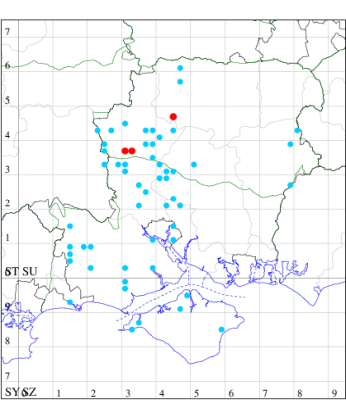
Records by year
Records by week (adult)
Records by week (larval)
Record Details
VC12: Nether Wallop, one, 02 Sep; one, 18 Aug; Hurstbourne Priors, one, 09 Jun (GCE)
73.345 [B&F: 2109] Lesser Yellow Underwing Noctua comes Hübner, [1813] - Common
Common in a wide range of habitats, including gardens, downland, heathland, woodland and moorland throughout the British Isles. Widespread and common in Hampshire and on the Isle of Wight. Wingspan 38-48 mm. Could be confused with the much rarer Lunar Yellow Underwing N. orbona, which see. Larva feeds on Stinging Nettle, Broad-leaved Dock and Foxglove.
Records prior to 2022
| Vice County | #Records | #Individuals | First Record | Last Record |
|---|---|---|---|---|
| 10 | 1084 | 2502 | 1957 | 2021 |
| 11 | 16384 | 47459 | 200 | 2021 |
| 12 | 3741 | 11377 | 1949 | 2021 |
2022 records
| Vice County | #Records | #Individuals | Max Quantity |
|---|---|---|---|
| 10 | 111 | 244 | 10 |
| 11 | 548 | 1227 | 15 |
| 12 | 196 | 543 | 29 |
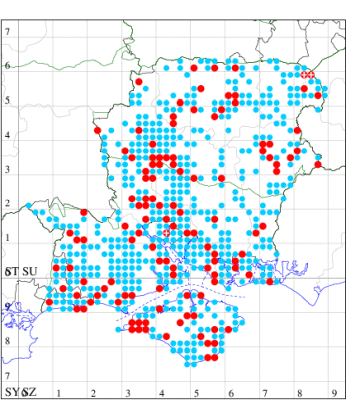
Records by year
Records by week (adult)
Records by week (larval)
Record Summary
VC10: Earliest: Tennyson Down, 18 Sep, 2 (PBar) Latest: Sandown, 29 Jul, 1 (IOu) Max count: Freshwater Bay, 19 Sep, 10 (SDav)
VC11: Earliest: Brockwood, 06 Oct, 2 (SDut) Latest: Hayling Island, 22 Jul, 2 (STho) Max count: Portsmouth, 22 Sep, 15 (IRT)
VC12: Earliest: Cholderton, 19 Jul, 0 (TJN) Latest: Farnborough, 26 Oct, 1 (KBW) Max count: Whitehill, 04 Oct, 29 (ASto)
73.346 [B&F: 2112] Least Yellow Underwing Noctua interjecta Hübner, [1803] - Common
Common in hedgerows, gardens, fens, sand-dunes and other open areas throughout England and Wales. Widespread and fairly common in Hampshire and on the Isle of Wight. Wingspan 31-36 mm. The least frequent of the five common Noctua species. Larva feeds on various grasses, and herbaceous plants such as Meadowsweet, Common Mallow and Hawthorn.
Records prior to 2022
| Vice County | #Records | #Individuals | First Record | Last Record |
|---|---|---|---|---|
| 10 | 124 | 148 | 1973 | 2021 |
| 11 | 1984 | 2632 | 1951 | 2021 |
| 12 | 611 | 859 | 1900 | 2021 |
2022 records
| Vice County | #Records | #Individuals | Max Quantity |
|---|---|---|---|
| 10 | 14 | 18 | 4 |
| 11 | 66 | 79 | 7 |
| 12 | 33 | 47 | 4 |
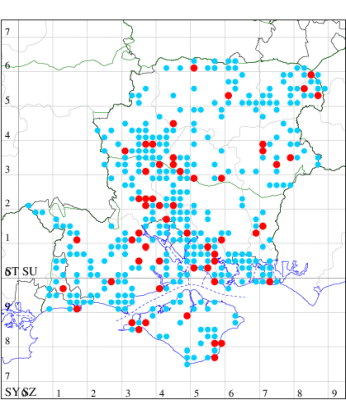
Records by year
Records by week (adult)
Records by week (larval)
Record Summary
VC10: Earliest: Totland, 30 Jul, 1 (RTer) Latest: Shanklin Upper Chine, 04 Aug, 4 (IOu) Max count: Shanklin Upper Chine, 04 Aug, 4 (IOu)
VC11: Earliest: Furzehill, NF, 01 Aug, 1 (SLoa) Latest: Hayling Island, 04 Sep, 1 (STho) Max count: Brownwich cliffs, 29 Jul, 7 (MLO, DWal, KJW)
VC12: Earliest: Nether Wallop, 08 Aug, 1 (GCE) Latest: Farnborough, 07 Aug, 1 (KBW) Max count: Chilbolton, 24 Jul, 4 (GCE)
73.347 [B&F: 2110a] Langmaid's Yellow Underwing Noctua janthina [Denis & Schiffermüller], 1775 - Recent colonist
An immigrant from mainland Europe, appearing in southern England, and now resident in small numbers along the south coast. First recorded in Britain by John Langmaid at Southsea, Hampshire, on 9 July 2001. Steadily increasing in frequency throughout the first two decades of the 21st century, it is now accepted as likely to be a low-density breeding species in parts of Hampshire and Isle of Wight. Wingspan 34-40 mm. Very similar to Lesser Broad-bordered Yellow Underwing N. janthe, from which separable in some cases only by dissection of genitalia. Set specimens of N. janthina are separable by black outer border of hindwing, which on N. janthe either stops before the costa or extends diffusely along it, while on N. janthina, it is generally broader, and extends along costa without a gap, so the overall effect is of a black hindwing with a yellow spot. On underside of forewing of N. janthe, the distal edge of black area is usually distinctly toothed. Larva feeds on various herbaceous plants. Some authorities dispute whether janthina is a separate species, as there is evidence of hybridisation on the continent.
Records prior to 2022
| Vice County | #Records | #Individuals | First Record | Last Record |
|---|---|---|---|---|
| 10 | 1 | 1 | 2021 | 2021 |
| 11 | 300 | 388 | 2001 | 2021 |
| 12 | 9 | 9 | 2019 | 2021 |
2022 records
| Vice County | #Records | #Individuals | Max Quantity |
|---|---|---|---|
| 10 | 12 | 18 | 3 |
| 11 | 60 | 98 | 15 |
| 12 | 15 | 20 | 4 |
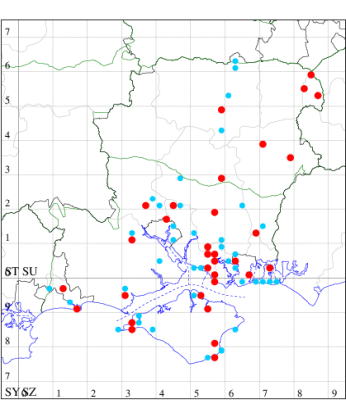
Records by year
Records by week (adult)
Records by week (larval)
Record Details
VC10: West High Down quarries, two, 12 Jul (IOu); Totland, one, 27 Jul (RTer); Bonchurch, one, 22 Jun; two, 27 Jun; one, 29 Jun; one, 06 Jul; two, 15 Jul; two, 17 Jul (JHa); Shanklin, one, 05 Aug; Osborne Wood, three, 18 Jul; one, 13 Aug; Firestone Copse, one, 21 Jun (IOu);
VC11: Woodlands, NF, one, underwing checked, 18 Jul (RBW); Romsey, one, 09 Jul; one, 15 Jul; one, 31 Jul; one, 04 Aug; one, 07 Aug; two, 09 Aug (MJB); Swaythling, Southampton, one, 22 Jul; two, 31 Jul; one, 20 Aug (MEdg); Allbrook, one, 04 Aug; three, 05 Aug; one, 10 Aug (SIng); Fareham, two, 31 Jul (IMcP); Stubbington, one, 29 Jul; one, 31 Jul (DPH); Funtley, one, 18 Jul; two, 30 Jul; one, 03 Aug; eight, 04 Aug; four, 11 Aug; five, 24 Aug; one, 27 Aug; three, 28 Aug; two, 31 Aug; one, 03 Sep (TDC); Lee-on-Solent, one, 09 Jul (IHrg); Fareham, one, 16 Jul; one, 02 Aug; two, 04 Aug (ADT); one, 07 Jul (IMcP); one, 23 Jul; one, 09 Aug; one, 13 Aug (MLO); one, 09 Aug; one, checked, 10 Aug (KJW); The Hangers, Bishops Waltham, 15, 06 Aug (SIng); Portchester, one, 06 Aug; one, 13 Aug (DH-J); Portsmouth, one, 06 Jul; one, 08 Jul; one, 09 Jul; one, 26 Jul; one, 30 Jul; one, 01 Aug; one, 13 Aug (IRT); Lovedean*, one, 06 Aug (ARJ); Northney, Hayling Island, present, 01 Jul (JWP); Hurn, one, underwing and underside of forewing checked, 21 Jul; one, 28 Jul; one, 04 Aug; one, 12 Aug; one, 26 Aug; one, 28 Aug; Hengistbury Head, one, 01 Aug; one, 03 Jul (MJef); Pennington, one, 06 Aug (RFC); Browndown Coastal Ranges, two, checked, 08 Jul (RJD, ADT, DWal & KJW); one, 15 Jul (MLO, ADT, DWal & KJW); one, checked, 12 Aug (KCok, RJD, MLO, ADT, DWal);
VC12: Hinton Ampner*, four, 19 Jul; one, 20 Jul (ASD); Basingstoke, two, 29 Jul; two, 05 Aug; one, 10 Aug; one, 12 Aug (GAH); Whitedown, Alton, one, 29 Jul (BCA det. MJW); Whitehill, one, 18 Jul; one, 03 Aug (ASto); Fleet Pond, one, specimen retained but needs to be verified, 04 Oct (MHals); Blackwater, one, 18 Jul; one, 24 Jul; one, 02 Aug; one, 09 Aug; one, 14 Aug (BGD)
73.348 [B&F: 2111] Lesser Broad-bordered Yellow Underwing Noctua janthe (Borkhausen, 1792) - Common
Common in a wide range of habitats, including woodland, hedgerows, gardens, heathland and moorland throughout the British Isles. Widespread and common in Hampshire and on the Isle of Wight. Wingspan 34-44 mm. Could be confused with the much rarer Langmaid's Yellow Underwing N. janthina, which see. Larva feeds on various herbaceous plants, including White Dead-nettle, Broad-leaved Dock and Scentless Mayweed.
Records prior to 2022
| Vice County | #Records | #Individuals | First Record | Last Record |
|---|---|---|---|---|
| 10 | 1197 | 7654 | 1977 | 2021 |
| 11 | 12250 | 49877 | 200 | 2021 |
| 12 | 3586 | 21237 | 1950 | 2021 |
2022 records
| Vice County | #Records | #Individuals | Max Quantity |
|---|---|---|---|
| 10 | 212 | 1295 | 64 |
| 11 | 850 | 3315 | 75 |
| 12 | 303 | 1235 | 42 |
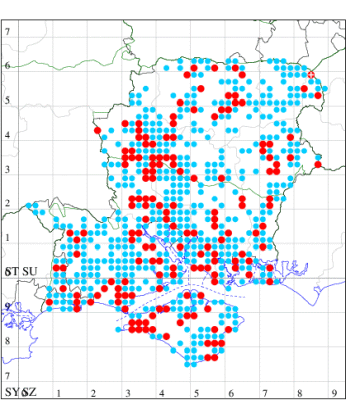
Records by year
Records by week (adult)
Records by week (larval)
Record Summary
VC10: Earliest: Tennyson Down, 18 Sep, 2 (PBar) Latest: Sandown, 29 Jul, 7 (IOu) Max count: Shanklin, 13 Aug, 64 (IOu)
VC11: Earliest: Brockwood, 19 Aug, 1 (SDut) Latest: Hayling Island, 04 Sep, 1 (STho) Max count: Sway, 23 Aug, 75 (SKee)
VC12: Earliest: Cholderton, 19 Jul, 0 (TJN) Latest: Farnborough, 24 Oct, 1 (KBW) Max count: Overton, 17 Aug, 42 (ACr)
73.350 [B&F: 2137] Great Brocade Eurois occulta (Linnaeus, 1758) - Nationally Scarce
Nationally scarce (Na) in bogs, marshes, scrubby moorland and woodland, in the central and western Scottish Highlands. Also appears as an immigrant, mostly in north Scotland and the Scottish islands, the whole of north England, and down the east coast to Essex and Kent, with scattered records inland and as far west as Cornwall, Isle of Man, and Co. Clare in Ireland. In Hampshire and on the Isle of Wight generally a scarce migrant, recorded from time to time in all three vice-counties, however in 2006 a huge influx occurred with in excess of 30 across the county. Wingspan 52-64 mm. Both resident and immigrant forms could be confused with Grey Arches Polia nebulosa, which flies at the same time and in similar habitats to the resident populations, but this has the orbicular stigma rounded, the reniform stigma less excavated, and hindwing paler with a dark marginal line before the cilia (MBGBI Vol 9). Larva feeds on Bog-myrtle.
Records prior to 2022
| Vice County | #Records | #Individuals | First Record | Last Record |
|---|---|---|---|---|
| 10 | 6 | 7 | 1857 | 2006 |
| 11 | 38 | 29 | 1931 | 2007 |
| 12 | 32 | 28 | 1940 | 2007 |
2022 records
| Vice County | #Records | #Individuals | Max Quantity |
|---|---|---|---|
| 11 | 1 | 1 | 1 |
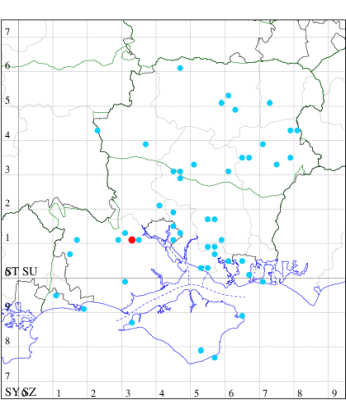
Records by year
Records by week (adult)
Records by week (larval)
Record Details
VC11: Woodlands, NF, one, 01 Sep (RBW)
73.352 [B&F: 2138] Green Arches Anaplectoides prasina ([Denis & Schiffermüller], 1775) - Common
Common in broad-leaved, especially damp, woodland throughout the British Isles; widely distributed in Hampshire and the Isle of Wight, but rarely numerous, with no evidence of any real decline. Wingspan 43-53 mm. Larva feeds on numerous herbaceous and woody plants, including Primrose, Knotgrass, Sallow, Dock, Honeysuckle, Bramble and Bilberry.
Records prior to 2022
| Vice County | #Records | #Individuals | First Record | Last Record |
|---|---|---|---|---|
| 10 | 161 | 272 | 1856 | 2021 |
| 11 | 231 | 187 | 1949 | 2021 |
| 12 | 354 | 464 | 1951 | 2021 |
2022 records
| Vice County | #Records | #Individuals | Max Quantity |
|---|---|---|---|
| 10 | 13 | 16 | 2 |
| 11 | 1 | 1 | 1 |
| 12 | 1 | 1 | 1 |
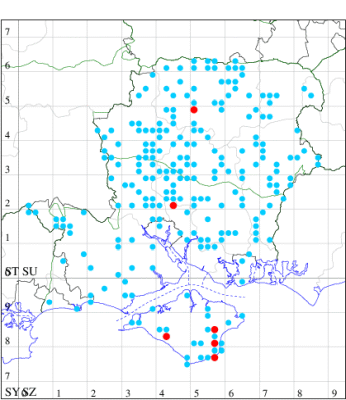
Records by year
Records by week (adult)
Records by week (larval)
Record Details
VC10: Brighstone, two, 18 Jun (AMas); Bonchurch, one, 29 Jun (JHa); Shanklin, one, 30 May; one, 10 Jun; one, 11 Jun; two, 20 Jun; one, 25 Jun; one, 29 Jun; two, 30 Jun; one, 03 Jul; one, 08 Jul; one, 11 Jul (IOu); Alverstone, one, 23 Jul (DFai);
VC11: Allbrook, one, 22 Jun (SIng);
VC12: Overton, one, 28 Jul (ACr)
73.353 [B&F: 2130] Dotted Clay Xestia baja ([Denis & Schiffermüller], 1775) - Common
Common in woodland, heathland, scrubby grassland and marshes throughout the British Isles. In Hampshire widely distributed, but not particularly common and generally absent from the chalk. Not recorded from the Isle of Wight since 1982. Wingspan 38-44 mm. Combination of general appearance and two black dots close to apex of forewing is distinctive. Larva feeds on herbaceous plants such as Primrose, Stinging Nettle and Dock in autumn, and woody plants such as Blackthorn, Bog-myrtle and Willow in spring.
Records prior to 2022
| Vice County | #Records | #Individuals | First Record | Last Record |
|---|---|---|---|---|
| 10 | 8 | 1 | 1856 | 1982 |
| 11 | 489 | 541 | 1951 | 2021 |
| 12 | 166 | 243 | 1951 | 2021 |
2022 records
| Vice County | #Records | #Individuals | Max Quantity |
|---|---|---|---|
| 11 | 10 | 9 | 1 |
| 12 | 2 | 3 | 2 |
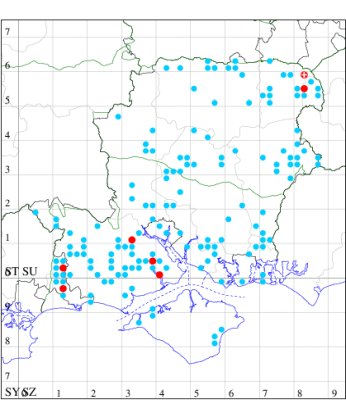
Records by year
Records by week (adult)
Records by week (larval)
Record Details
VC11: Avon Heath Country Park, one, 16 Aug (Rbis); Beaulieu, one, 07 Aug (MMcM); Woodlands, NF, present, 22 Aug (RBW); one, 14 Aug (CJon); Needs Ore NNR, one, 20 Aug (CNB); Hurn, one, 02 Aug; one, 05 Aug; one, 14 Aug; one, 21 Aug; one, 03 Sep (MJef);
VC12: Fleet Pond, one, 14 Aug (MHals); Yateley Common, larva, two, beaten, on Betula pendula, 15 Apr (BGD)
73.355 [B&F: 2132] Neglected Rustic Xestia castanea (Esper, 1798) - Local
Local on heathland and moorland, and in bogs throughout the British Isles, a species of conservation concern under the UK Biodiversity Action Plan. In Hampshire common on heathland in the New Forest and in the north-east, but uncommon elsewhere and on the Isle of Wight. Wingspan 36-42 mm. Variable, with the grey form neglecta more common in the south of Britain, and red forms in the north of Britain; in north-east Hampshire both grey and red forms occur. The grey form may be confused with Square-spot Rustic X. xanthographa, but X. castanea always characterised by reniform and orbicular stigmata inconspicuous, concolorous with ground colour, outlined ochreous, and reniform stigma with dark dot in dorsal half (MBGBI Vol 9). Larva feeds on Heather, Bell Heather and Cross-leaved Heath.
Records prior to 2022
| Vice County | #Records | #Individuals | First Record | Last Record |
|---|---|---|---|---|
| 10 | 7 | 1 | 1856 | 2019 |
| 11 | 430 | 524 | 1949 | 2021 |
| 12 | 87 | 104 | 1951 | 2021 |
2022 records
| Vice County | #Records | #Individuals | Max Quantity |
|---|---|---|---|
| 11 | 17 | 18 | 2 |
| 12 | 9 | 12 | 2 |
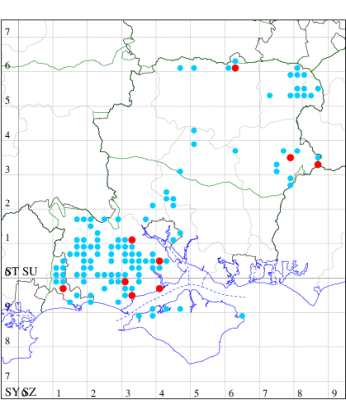
Records by year
Records by week (adult)
Records by week (larval)
Record Details
VC11: Woodlands, NF, present, 22 Aug (RBW); Dibden Purlieu, one, 05 Sep; two, 06 Sep; one, 07 Sep; one, 11 Sep; one, 12 Sep; one, 13 Sep; one, 19 Sep; one, 20 Sep; one, 21 Sep; one, 22 Sep; one, 23 Sep (RAC); Hurn, one, 26 Aug; one, 15 Sep (MJef); Lower Sandy Down, East Boldre, two, 30 Aug (DMor); Lymington, one, 02 Sep (PRD); Needs Ore NNR, one, 09 Sep (CNB);
VC12: Pamber Forest, one, 24 Aug; two, 02 Sep (GJD); Whitehill, one, 26 Aug; one, 28 Aug; one, 02 Sep; two, 05 Sep; two, 12 Sep; one, 21 Sep (ASto); Hammer Vale, Woolmer, one, 21 Aug (ASwa)
73.356 [B&F: 2135] Heath Rustic Xestia agathina (Duponchel, 1827) - Local
Local on acid heathland and moorland throughout much of the British Isles, a species of conservation concern under the UK Biodiversity Action Plan. In Hampshire and on the Isle of Wight locally common on heaths, especially the New Forest, although has suffered from habitat destruction in a number of former haunts, especially in the north-east. It is an occasional wanderer elsewhere. Wingspan 28-36 mm. A constant feature is the small, pale, very oblique orbicular stigmata. Larva feeds on Heather.
Records prior to 2022
| Vice County | #Records | #Individuals | First Record | Last Record |
|---|---|---|---|---|
| 10 | 25 | 28 | 1958 | 2020 |
| 11 | 508 | 670 | 1951 | 2021 |
| 12 | 37 | 47 | 1951 | 2021 |
2022 records
| Vice County | #Records | #Individuals | Max Quantity |
|---|---|---|---|
| 10 | 3 | 3 | 1 |
| 11 | 13 | 16 | 3 |
| 12 | 3 | 7 | 5 |
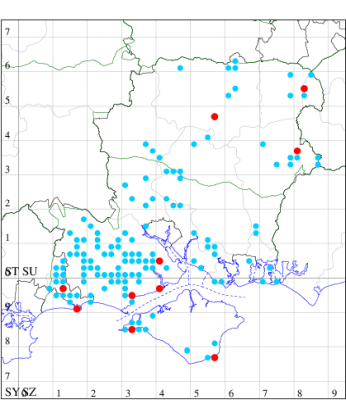
Records by year
Records by week (adult)
Records by week (larval)
Record Details
VC10: West High Down quarries, one, 22 Sep (MGT); Bonchurch, one, 20 Sep; one, 21 Sep (JHa);
VC11: Dibden Purlieu, one, 12 Sep; three, 13 Sep; one, 14 Sep; one, 15 Sep; one, 19 Sep; one, 20 Sep; one, 22 Sep; one, 16 Oct (RAC); Hurn, one, 22 Sep; Hengistbury Head, one, 26 Sep (MJef); Lymington, one, 02 Sep (PRD); Needs Ore NNR, two, 11 Aug; one, 02 Sep (CNB);
VC12: North Waltham, one, 04 Sep (AJon); Broxhead Common, one, 04 Aug (KBW, HthRT det. KBW); Fleet Pond, five, 14 Apr (MHals)
73.357 [B&F: 2134] Square-spot Rustic Xestia xanthographa ([Denis & Schiffermüller], 1775) - Common
Common in grassland, gardens and woodland rides throughout the British Isles. In Hampshire and on the Isle of Wight abundant in areas of grassland and open woodland, and amongst the rank grasses of the chalk downs. Wingspan 32-40 mm. The pale reniform stigma of Square-spot Rustic should preclude confusion with any other species; the much less common Garden Dart Euxoa nigricans has the forewing narrower and a conspicuous claviform stigma (MBGBI Vol 9). Larva feeds on various grasses.
Records prior to 2022
| Vice County | #Records | #Individuals | First Record | Last Record |
|---|---|---|---|---|
| 10 | 1379 | 9395 | 1951 | 2021 |
| 11 | 17323 | 87261 | 200 | 2021 |
| 12 | 4310 | 31005 | 1951 | 2021 |
2022 records
| Vice County | #Records | #Individuals | Max Quantity |
|---|---|---|---|
| 10 | 207 | 1316 | 115 |
| 11 | 946 | 4725 | 51 |
| 12 | 302 | 1835 | 73 |
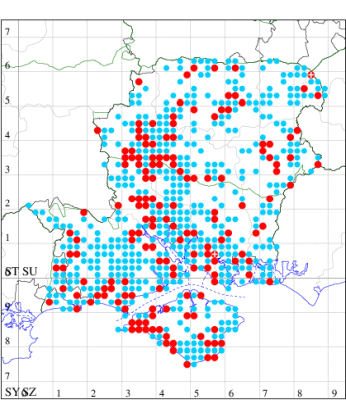
Records by year
Records by week (adult)
Records by week (larval)
Record Summary
VC10: Earliest: Tennyson Down, 15 Sep, 10 (PBar) Latest: Osborne Wood, 14 Sep, 11 (IOu) Max count: Cowleaze Chine, 25 Sep, 115 (IOu)
VC11: Earliest: Brockwood, 06 Oct, 2 (SDut) Latest: Hayling Island, 01 Sep, 4 (STho) Max count: Lovedean, 19 Sep, 51 (ARJ)
VC12: Earliest: Cholderton, 11 Sep, 40 (TJN) Latest: Farnborough, 25 Sep, 6 (KBW) Max count: Ecchinswell, 12 Sep, 73 (MJN)
73.358 [B&F: 2133] Six-striped Rustic Xestia sexstrigata (Haworth, 1809) - Common
Common in water meadows, marshes, fens, damp woodland, hedgerows, gardens and downland throughout much of the British Isles. In Hampshire and on the Isle of Wight widespread and common. Wingspan 36-38 mm. Fairly unmistakable. Larva polyphagous on herbaceous plants such as Hedge Bedstraw, Ribwort Plantain, Bramble, Bluebell and Water Figwort.
Records prior to 2022
| Vice County | #Records | #Individuals | First Record | Last Record |
|---|---|---|---|---|
| 10 | 169 | 314 | 1903 | 2021 |
| 11 | 2616 | 6653 | 1951 | 2021 |
| 12 | 885 | 2575 | 1951 | 2021 |
2022 records
| Vice County | #Records | #Individuals | Max Quantity |
|---|---|---|---|
| 10 | 28 | 44 | 5 |
| 11 | 154 | 385 | 13 |
| 12 | 48 | 99 | 12 |
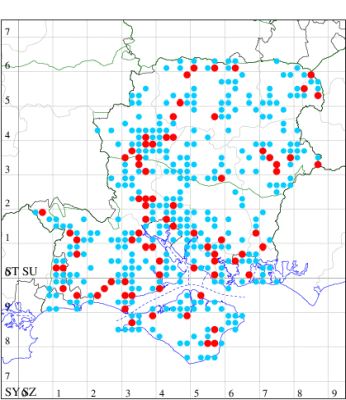
Records by year
Records by week (adult)
Records by week (larval)
Record Summary
VC10: Earliest: Totland, 25 Jul, 2 (RTer) Latest: Osborne Wood, 13 Aug, 5 (IOu) Max count: Osborne Wood, 13 Aug, 5 (IOu)
VC11: Earliest: Brockwood, 19 Aug, 1 (SDut) Latest: Needs Ore NNR, 02 Sep, 3 (CNB) Max count: Hurn, 03 Sep, 13 (MJef)
VC12: Earliest: Broughton, 18 Aug, 1 (GCE) Latest: Farnborough, 22 Aug, 1 (KBW) Max count: Ecchinswell, 14 Aug, 12 (MJN)
73.359 [B&F: 2126] Setaceous Hebrew Character Xestia c-nigrum (Linnaeus, 1758) - Common
Common often abundant, especially in autumn, in a wide variety of habitats, including gardens, woodland, heathland and marshes throughout the British Isles. Widespread and extremely common in Hampshire and on the Isle of Wight. Wingspan 35-45 mm. One of the most frequent visitors to light traps in autumn and very easily recognised, the most likely confusion species is Double Square-spot X. triangulum. Larva feeds on a wide variety on herbaceous plants, including Stinging Nettle, White Dead-nettle, Great Willowherb, Rosebay Willowherb and Greater Burdock.
Records prior to 2022
| Vice County | #Records | #Individuals | First Record | Last Record |
|---|---|---|---|---|
| 10 | 1861 | 9853 | 1951 | 2021 |
| 11 | 21678 | 104625 | 200 | 2021 |
| 12 | 6627 | 57538 | 1951 | 2021 |
2022 records
| Vice County | #Records | #Individuals | Max Quantity |
|---|---|---|---|
| 10 | 286 | 1257 | 58 |
| 11 | 1045 | 5045 | 215 |
| 12 | 477 | 4163 | 180 |
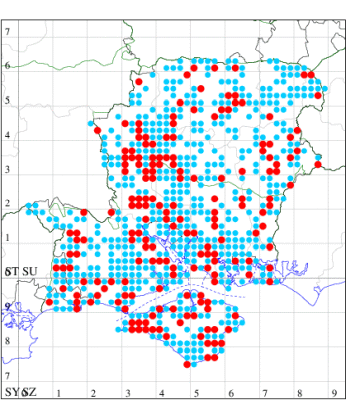
Records by year
Records by week (adult)
Records by week (larval)
Record Summary
VC10: Earliest: Tennyson Down, 15 Sep, 1 (PBar) Latest: Upper Green, 11 Aug, 1 (SHug) Max count: Totland, 02 Sep, 58 (RTer)
VC11: Earliest: Brockwood, 14 Aug, 1 (SDut) Latest: Hayling Island, 01 Sep, 21 (STho) Max count: Crawley, 29 Aug, 215 (GCE)
VC12: Earliest: Cholderton, 01 Jul, 3 (TJN) Latest: Farnborough, 12 Sep, 2 (KBW) Max count: Morn Hill, Winchester, 27 Aug, 180 (CRB, DAS, PDF et al)
73.361 [B&F: 2128] Double Square-spot Xestia triangulum (Hufnagel, 1766) - Common
Common in deciduous woodland, hedgerows and gardens throughout the British Isles, where it is far more frequent than the superficially similar Triple-spotted Clay X. ditrapezium. Widespread and common in Hampshire and on the Isle of Wight. Wingspan 36-46 mm. Larva feeds on Meadow Buttercup, Primrose, Cow Parsley and Wood Spurge.
Records prior to 2022
| Vice County | #Records | #Individuals | First Record | Last Record |
|---|---|---|---|---|
| 10 | 364 | 747 | 1951 | 2021 |
| 11 | 4268 | 6878 | 1951 | 2021 |
| 12 | 2437 | 6318 | 1948 | 2021 |
2022 records
| Vice County | #Records | #Individuals | Max Quantity |
|---|---|---|---|
| 10 | 41 | 113 | 15 |
| 11 | 205 | 381 | 21 |
| 12 | 123 | 247 | 21 |
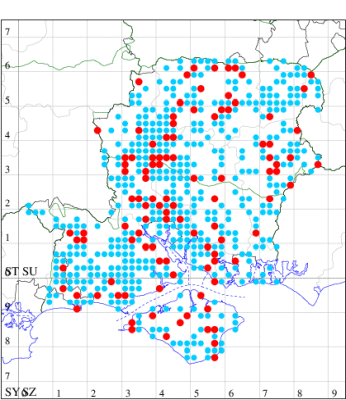
Records by year
Records by week (adult)
Records by week (larval)
Record Summary
VC10: Earliest: West High Down quarries, 12 Jul, 10 (IOu) Latest: Firestone Copse, 21 Jun, 2 (IOu) Max count: Osborne Wood, 18 Jul, 15 (IOu)
VC11: Earliest: St Leonards, 23 Jul, 5 (SDut) Latest: Browndown Coastal Ranges, 08 Jul, 1 (RJD, ADT, DWal & KJW) Max count: Hurn, 28 Jun, 21 (MJef)
VC12: Earliest: Cholderton, 01 Jul, 7 (TJN) Latest: Blackwater, 24 Jul, 1 (BGD) Max count: Noar Hill HIWWT NR, Selborne, 08 Jul, 21 (IBla)
73.365 [B&F: 2117] Autumnal Rustic Eugnorisma glareosa (Esper, 1788) - Common
Common in heathland, moorland, rough grassland and downland throughout the British Isles, a species of conservation concern under the UK Biodiversity Action Plan. Local in Hampshire and on the Isle of Wight, with occasional wanderers turning up away from established localities. Wingspan 32-38 mm. Unlikely to be confused with any other British species, except on Shetland where Ingrailed Clay Diarsia mendica thulei resembles E. glareosa f. edda. Larva feeds on Heather, Bell Heather, Silver and Downy Birch, Bedstraw, Bluebell.
Records prior to 2022
| Vice County | #Records | #Individuals | First Record | Last Record |
|---|---|---|---|---|
| 10 | 88 | 98 | 1856 | 2021 |
| 11 | 774 | 1284 | 1951 | 2021 |
| 12 | 256 | 513 | 1951 | 2021 |
2022 records
| Vice County | #Records | #Individuals | Max Quantity |
|---|---|---|---|
| 10 | 2 | 1 | 1 |
| 11 | 26 | 33 | 4 |
| 12 | 14 | 21 | 7 |
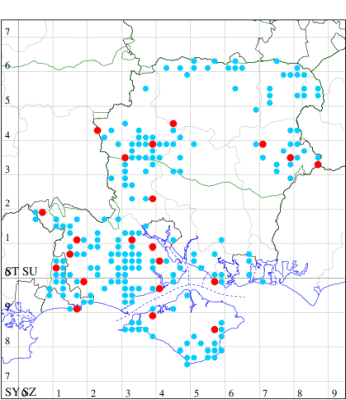
Records by year
Records by week (adult)
Records by week (larval)
Record Details
VC10: Cranmore, present, 25 Sep (CHic); Alverstone, one, 23 Oct (DFai); Cranmore, present, 25 Sep (CHic); Alverstone, one, 23 Oct (DFai);
VC11: Brockwood, three, 06 Oct (SDut); Blashford Lakes HIWWT NR, one, 24 Sep (NTO); Furzehill, NF, one, 03 Oct (SLoa); Marchwood, one, 04 Sep (CTha); Woodlands, NF, present, 01 Sep (RBW); Romsey, one, 31 Aug; one, 04 Sep; one, 24 Sep; one, 28 Sep (NRJ); Dibden Purlieu, one, 29 Aug; one, 30 Aug; one, 31 Aug; one, 01 Sep; one, 17 Sep; one, 19 Sep; one, 20 Sep (RAC); Hengistbury Head, one, 12 Sep (MoTay); four, 16 Sep (BKin); two, 10 Oct (MJef); one, 12 Oct (RPH); one, 13 Oct (PWet); two, 19 Oct (MoTay det. RPH); Thorney Hill, Bransgore, one, 27 Aug (JFen); Needs Ore NNR, two, 02 Sep; one, 09 Sep (CNB); Browndown Coastal Ranges, one, 28 Oct (RJD, MLO, DWal, KJW); Brockwood, three, 06 Oct (SDut); Blashford Lakes HIWWT NR, one, 24 Sep (NTO); Furzehill, NF, one, 03 Oct (SLoa); Marchwood, one, 04 Sep (CTha); Woodlands, NF, present, 01 Sep (RBW); Romsey, one, 31 Aug; one, 04 Sep; one, 24 Sep; one, 28 Sep (NRJ); Dibden Purlieu, one, 29 Aug; one, 30 Aug; one, 31 Aug; one, 01 Sep; one, 17 Sep; one, 19 Sep; one, 20 Sep (RAC); Hengistbury Head, one, 12 Sep (MoTay); four, 16 Sep (BKin); two, 10 Oct (MJef); one, 12 Oct (RPH); one, 13 Oct (PWet); two, 19 Oct (MoTay det. RPH); Thorney Hill, Bransgore, one, 27 Aug (JFen); Needs Ore NNR, two, 02 Sep; one, 09 Sep (CNB); Browndown Coastal Ranges, one, 28 Oct (RJD, MLO, DWal, KJW);
VC12: Cholderton, two, 11 Sep (TJN); Nether Wallop, one, 02 Sep; Chilbolton, seven, 19 Sep; one, 04 Oct; one, 18 Oct; Longparish, one, 03 Oct (GCE); Alton, one, 23 Sep (DBO); Whitehill, one, 19 Sep; one, 21 Sep; one, 22 Sep; one, 25 Sep; one, 06 Oct (ASto); Hammer Vale, Woolmer, one, 06 Sep; one, 08 Sep (ASwa)Cholderton, two, 11 Sep (TJN); Nether Wallop, one, 02 Sep; Chilbolton, seven, 19 Sep; one, 04 Oct; one, 18 Oct; Longparish, one, 03 Oct (GCE); Alton, one, 23 Sep (DBO); Whitehill, one, 19 Sep; one, 21 Sep; one, 22 Sep; one, 25 Sep; one, 06 Oct (ASto); Hammer Vale, Woolmer, one, 06 Sep; one, 08 Sep (ASwa)
